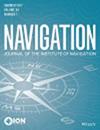利用低成本惯性辅助定位杆将实时运动学测量方法扩展到全球导航卫星系统拒绝区域
IF 2
3区 地球科学
Q1 ENGINEERING, AEROSPACE
引用次数: 0
摘要
全球导航卫星系统(GNSS)实时运动学(RTK)测量方法在GNSS屏蔽区域无法使用,很大程度上是由于信号阻塞。在这项工作中,我们的目标是通过使用包含廉价惯性测量单元(IMU)芯片和RTK接收器的惯性辅助定位杆的后处理,将高精度RTK定位能力扩展到gnss拒绝区域。通过使用杆作为手杖,杆周期性地落地,定位精度可以保持在可接受的水平。由于极尖速度在与固体地面接触时为零,杠杆臂补偿零速度更新(LA-ZUPTs)可以用于抑制gnss拒绝区域惯性导航系统(INS)的误差。实验结果表明,该方法可以桥接60米的GNSS间隙,以保持亚分米级的测量精度。本文章由计算机程序翻译,如有差异,请以英文原文为准。
Extending the Real-Time Kinematics Survey Method to Global Navigation Satellite System-Denied Areas Using a Low-Cost Inertial-Aided Positioning Pole
The global navigation satellite system (GNSS) real-time kinematics (RTK) survey method cannot be used in GNSS-denied areas largely due to signal block-age. In this work, we aim to extend high-precision RTK positioning capability to GNSS-denied areas via post-processing using an inertial-aided positioning pole that contains a inexpensive inertial measurement unit (IMU) chip and an RTK receiver. The positioning accuracy can be maintained at an acceptable level by using the pole as a walking stick with the pole periodically landing on the ground. Because the pole tip velocity is zero when it maintains contact with solid ground, lever-arm compensated zero-velocity updates (LA-ZUPTs) can be used to suppress errors in the inertial navigation system (INS) in GNSS-denied areas. Experimental results reveal that this method can be used to bridge up to a 60-meter GNSS gap to maintain sub-decimeter-level survey accuracy.
求助全文
通过发布文献求助,成功后即可免费获取论文全文。
去求助
来源期刊

Navigation-Journal of the Institute of Navigation
ENGINEERING, AEROSPACE-REMOTE SENSING
CiteScore
5.60
自引率
13.60%
发文量
31
期刊介绍:
NAVIGATION is a quarterly journal published by The Institute of Navigation. The journal publishes original, peer-reviewed articles on all areas related to the science, engineering and art of Positioning, Navigation and Timing (PNT) covering land (including indoor use), sea, air and space applications. PNT technologies of interest encompass navigation satellite systems (both global and regional), inertial navigation, electro-optical systems including LiDAR and imaging sensors, and radio-frequency ranging and timing systems, including those using signals of opportunity from communication systems and other non-traditional PNT sources. Articles about PNT algorithms and methods, such as for error characterization and mitigation, integrity analysis, PNT signal processing and multi-sensor integration, are welcome. The journal also accepts articles on non-traditional applications of PNT systems, including remote sensing of the Earth’s surface or atmosphere, as well as selected historical and survey articles.
 求助内容:
求助内容: 应助结果提醒方式:
应助结果提醒方式:


